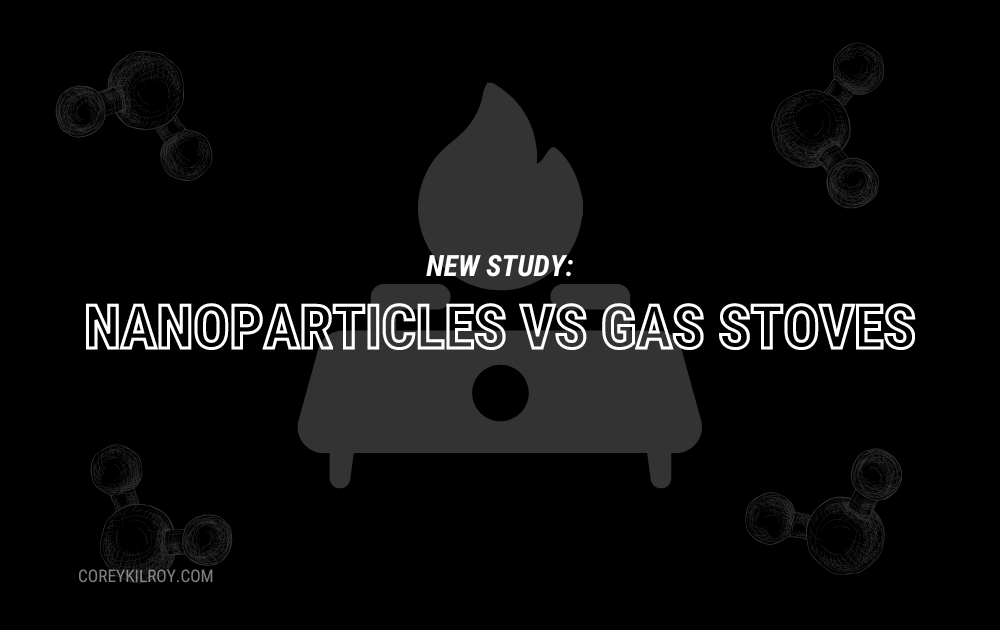New Study: Gas Stoves Release More Harmful Nanoparticles Than Your Car

“Cooking on your gas stove can emit more nano-sized particles into the air than vehicles that run on gas or diesel, possibly increasing your risk of developing asthma or other respiratory illnesses”, a new Purdue University study found.
This headline stunned me, too.
I grew up with a gas stove, and my mom and grandmother cooked delicious meals for my family all throughout my childhood on that gas stove.
Even further, I still currently use a gas stove to cook meals in my apartment as a young adult.
So being a Holistic Health “junky”, hearing that I could be ingesting trillions of nanoparticles by slaving over my stove really took me back.
Let’s dive a little deeper…
What are Nanoparticles?
Nanoparticles are materials with overall dimensions in the nanoscale, ie, under 100nm.
They’re so small that you’re not able to see them with the naked eye. They’re not like dust particles that you would see floating in the air.
These nanoparticles have been used for good in modern medicine, with clinical applications ranging from contrast agents in advanced imaging, to being carriers for drug and gene delivery into tumors.
However, these nanoparticles also introduce negative environmental and societal challenges with toxicity–like vehicle emission (source).
Because they’re so small, they can transmit toxins easily which poses a risk that can't be ignored.
Nanoparticles and Gas Stoves
As previously mentioned, Purdue University conducted a recent study that found that cooking on your gas stove produces large amounts of small nanoparticles that can get into your respiratory system and deposit toxins efficiently.
This is particularly troubling to hear if you have small children in your household as well since recent studies have found that children who live in homes with gas stoves are more likely to develop asthma.
How did they make these findings?
Purdue researchers were able to measure these nanoparticles down to a single nanometer while cooking on a gas stave in a “tiny house” lab they created.
They were able to do this by using a state-of-the-art air quality instrumentation provided by the German company GRIMM AEROSOL TECHNIK.
Called the Purdue Zero Energy Design Guidance for Engineers (zEDGE) lab, the tiny house has all the features of a typical home but is equipped with sensors for closely monitoring the impact of everyday activities on a home’s air quality.
With this testing environment and the instrument from GRIMM AEROSOL, the team was able to collect extensive data on indoor nanocluster aerosol particles during realistic cooking experiments.
This newfound data allowed the researchers to compare their findings with known outdoor air pollution levels (like vehicle emissions), which are more regulated and understood than indoor air pollution.
They found that as many as 10 quadrillion nanocluster aerosol particles could be emitted per kilogram of cooking fuel — matching or exceeding those produced from vehicles with internal combustion engines.
This would mean that adults and children could be breathing in 10-100 times more nanocluster aerosol from cooking on a gas stove indoors than they would from car exhaust while standing on a busy street.
Nusrat Jung, a Purdue assistant professor of civil engineering, compared it to “using a diesel engine exhaust pipe as an air supply to your kitchen”.
That’s a big no-no for me, dawg.
They even modeled various ways that nanocluster aerosol could transform while indoors and potentially deposit into a person’s respiratory system.
Those models showed that trillions of these particles were emitted within just 20 minutes of boiling a pot of water or making a simple grilled cheese, or even some buttermilk pancakes…
Even though many particles rapidly spread to other surfaces, the models still showed that about 10 billion to 1 trillion particles could deposit into an adult’s head airways and tracheobronchial region of the lungs.
These doses would be even higher for children, since the smaller the human, the more concentrated the dose.
What’s the solution?
If you have a gas stove, after hearing all of this you may be quickly searching for a loan for a new electric stove, but put the credit card away for now.
There are a couple of (obvious) remedies to these problems.
1. Turn on your kitchen exhaust fan/hood
Researchers say that a gas stove’s exhaust fan would likely redirect the nanoparticles away from your respiratory system, but that still remains to be tested.
And given that you’ve changed the exhaust filter within the past couple of years.
2. Open your windows while cooking
If you have one–and if the weather permits–try opening your kitchen window to promote airflow within your home and redirect those nanoparticles from entering your respiratory system.
This is my own logical treatment since having natural airflow through your home is never a bad thing, to begin with and should be done anyway to get rid of all that stale air.
In the end…
Don’t let this new study scare you into dropping a grand on a new electric stove.
Just be cautious when cooking and allow for ample exhaust and airflow throughout your kitchen.
Be well and Keep Pluggin.
-C.



